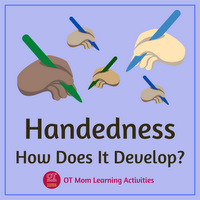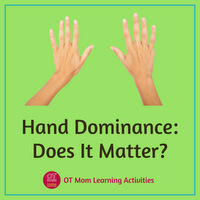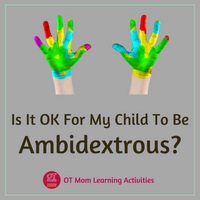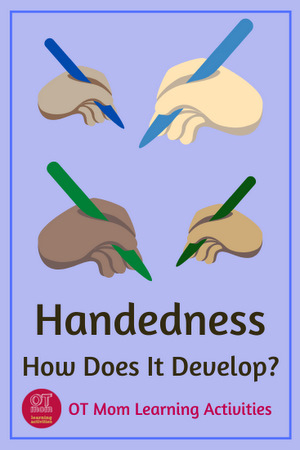- Home
- Hand Dominance
- Handedness
How Does Handedness Develop?
Have you ever wondered how a child's handedness develops? What contributes to the emergence of a dominant or preferred hand in children?
From an occupational therapist's perspective, here is a simplified overview of some of the processes that contribute to the development of a child's hand preference (hand dominance).
Bilateral Coordination in the Development of Handedness
Bilateral coordination skills begin to emerge in early babyhood. Babies love their hands, and they move both hands together to explore or touch something.
Moving both hands or both legs together like this is called symmetrical movement.
(If your baby under 18months does not move both hands together like this, and tends to leave one hand out completely, then see your doctor or paediatrician urgently.)
Some examples of symmetrical movements that we see in older children are jumping and clapping hands.
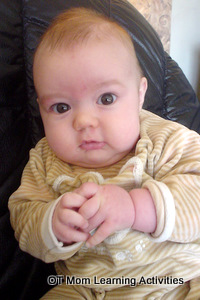 Baby playing with his hands
Baby playing with his handsAs your baby grows and develops, you should see the development of creeping/crawling skills. Creeping/crawling on all fours enables a baby to learn to move each side of the body in a rhythmical way, first one side and then the other. These are reciprocal movements.
Creeping/crawling is thus a vital part of a baby’s development, as it gives the baby tremendous opportunities to develop good bilateral coordination in preparation for handedness.
As the child grows and develops, more reciprocal skills such as walking, running, climbing and riding a tricycle develop. Both sides are doing the same task, one side at a time. Using both hands to pull in a rope is a good example of reciprocal bilateral coordination of the hands.
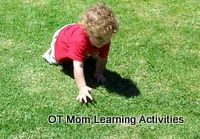 Reciprocal coordination: creeping/crawling
Reciprocal coordination: creeping/crawling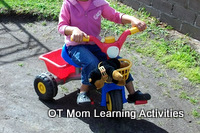 Reciprocal coordination: riding a tricycle
Reciprocal coordination: riding a tricycleThe next phase of bilateral coordination development is called asymmetrical bilateral coordination . This means that both sides of the body are working together, but they are doing a different, yet complementary task.
Look at this child coloring in. He has developed asymmetrical bilateral coordination skills as can be seen by one hand holding the paper while the other hand colors with a crayon.
Cutting with scissors, drawing on paper, kicking a
ball… these tasks all require that one hand or leg is “active” while
the other hand or leg “assists”.
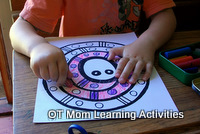 Holding down the paper while coloring
Holding down the paper while coloring
By age 4, most children have achieved
some measure of proficiency in developing assymetrical bilateral coordination skills - and then you should be seeing an "active" and a "helping" hand emerge.
Crossing the Midline in the Development of Handedness
As the child gets better at getting both hands to work together in a complementary way, the ability to cross the body's midline begins to emerge.
Crossing the midline means that one hand spontaneously moves over to the other side of the body to work there.
In this photo, the child is reaching over to the cards on the left side, using his right hand.
This is called crossing the midline.
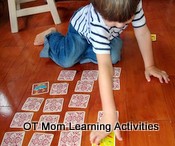 Crossing the midline while playing a game
Crossing the midline while playing a gameBefore crossing the midline is established, you may have noticed that your young child tends to use the left hand on the left side of the body and the right hand on the right side of the body.
So if your child is building a block tower with all the blocks placed in front, he/she may pick up the pieces on the left with the left hand, and the pieces on the right with the right hand.
And while drawing, or coloring, your child may spontaneously switch hands to color with the other hand. This is normal for young children!
However, in order for handedness to develop properly, crossing the midline needs to be an established skill. That means that the child needs to be comfortable spontaneously crossing the midline with either hand.
This will enable the dominant hand to get the practice that it needs in becoming skilled.
How To Help Your Child Develop A Preferred Hand
In order for handedness to emerge, your child’s bilateral coordination skills should be encouraged to develop – try some simple symmetrical and reciprocal activities from this page of my site.
If your child avoids crossing the midline, then both hands will tend to get equal practice at developing skills, and your child’s true handedness may be apparently delayed. Encourage a strong hand to emerge by making sure crossing the midline is not delayed – try these activities for crossing the midline!
The following pages of my site contain additional information as well as some research around this topic.
- Home
- Hand Dominance
- Handedness
If this page was helpful, please share it with your friends!
Didn't find what you were looking for? Try a search of my site!
